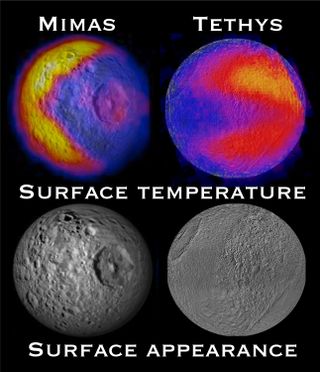Saturn's Second 'Pac-Man' Moon Revealed in NASA Photos

New images from a NASA spacecraft orbiting Saturn have revealed a view any retro-gamer would love: a second moon with a heat tattoo of the 1980s video game icon Pac-Man.
The latest images were snapped by NASA's Cassini spacecraft during a photo session of Saturn's icy moon Tethys, revealing an infrared pattern on the moon shaped like Pac-Man. It is the second time Cassini has found a Pac-Man heat pattern on a Saturn moon using its infrared spectrometer. In 2010, the spacecraft found a similar view on Saturn's moon Mimas, which is also known for a giant impact crater that gives it a similar look to the fictional Death Star of "Star Wars" fame.
"Finding a second Pac-Man in the Saturn system tells us the processes creating these Pac-Men are more widespread than previously thought," study leader Carly Howett said in a statement Monday (Nov. 26). "The Saturn system — and even the Jupiter system — could turn out to be a veritable arcade of these characters." [Amazing Saturn Photos by Cassini]

Scientists suspect that the Pac-Man shapes on Mimas and Tethys are created when high-energy electrons slam into low latitudes on the forward-facing sides of the moons as they orbit Saturn.
This bombardment transforms the normally "fluffy" surface into hard-packed ice, NASA officials said. The effect means that the hard-packed ice does not heat up as fast during the day or cool down as fast at night, they added.
The surface of Tethys is also regularly bombarded by icy particles from geysers on Enceladus, another Saturn moon. The Pac-Man heat signature on Tethys, however, suggests that the surface changes from electron bombardment are occurring faster than the recoating effect from Enceladus' plumes, researchers said.
"Studies at infrared wavelengths give us a tremendous amount of information about the processes that shape planets and moons," Cassini spectrometer principal investigator Mike Flasar of NASA's Goddard Space Flight Center in Greenbelt, Md., explained. "A result like this underscores just how powerful these observations are."
Sign up for the Live Science daily newsletter now
Get the world’s most fascinating discoveries delivered straight to your inbox.
Cassini's infrared spectrometer observations were obtained on Sept. 14, 2011. The research by Howett and her team is detailed in a recent edition of the science journal Icarus.
Howett and her colleagues found that the temperature on Tethys' surface varied depending on where in the Pac-Man they looked. The daytime temperature inside the Pac-Man shape's "mouth" was about 29 degrees Fahrenheit (minus 1.6 degrees Celsius) cooler than surrounding areas. The warmest temperature on Tethys, still a frigid minus 300 degrees F (minus 184 degrees C), was actually slightly colder than the warmest temperature on Mimas (about minus 290 degrees F or minus 178 degrees C).
Cassini's views of Tethys also confirmed that the Pac-Man heat map on the moon can also be spotted in visible-light images as a dark, lens-shaped area. The surface oddity was first sighted by NASA's Voyager spacecraft in 1980, but now finally explained.
"Finding a new Pac-Man demonstrates the diversity of processes at work in the Saturn system," said Cassini project scientist Linda Spilker of NASA's Jet Propulsion Laboratory in Pasadena, Calif. "Future Cassini observations may reveal other new phenomena that will surprise us and help us better understand the evolution of moons in the Saturn system and beyond."
NASA's Cassini spacecraft launched in 1997 and has been orbiting Saturn since its arrival at the ringed planet in 2004. Cassini is currently in the midst of an extended mission that runs through 2017.
This story was provided by SPACE.com, a sister site to Live Science. Follow SPACE.com on Twitter @Spacedotcom. We're also on Facebook & Google+.
Most Popular



